Welcome to a new issue of the Journal of Runic Studies, the premier Malkioni publication for studies into the nature of Glorantha. If you haven’t subscribed yet, please consult with the spirit bound to the appropriate electronic page.
This issue of the Journal is coming in a bit late because of Jeff’s massive “Gloranthan art” series, which required a bunch of research, and then I ran out of time this week-end. You may be interested (or not) to know that I really simply time-box these things: I do research until I’m satisfied, or until I run out of whatever time I’m comfortable spending on a free newsletter. Anyway, without further ado, here are your Gloranthan news for this week!
God Learner Sorcery
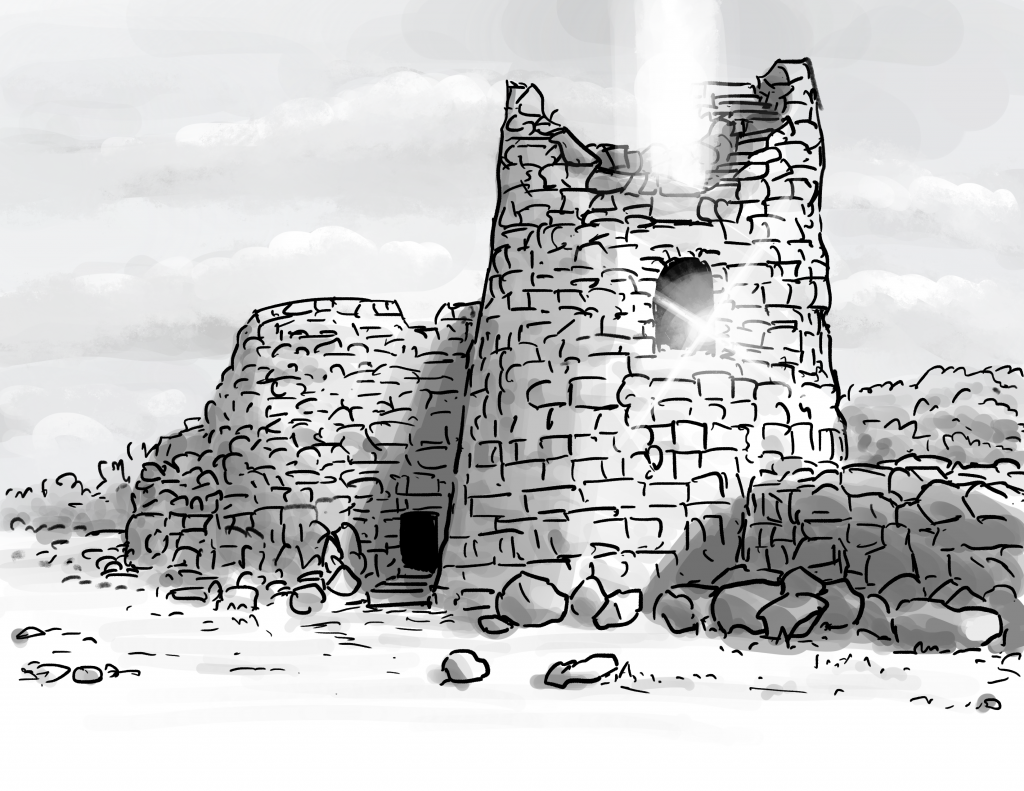
Here is what us God Learners were up to this week.
Glorantha Initiation Episode 5

This month we interview Steinar, also known as Coffeemancer on the BRP Central forums, where his illustrations became famous. As always with the Initiation Series, we discuss how the guest’s recent discovery of Glorantha happened, what was good, what was bad, and what was fun.
Chaosium News

Here are this week’s Chaosium news!
RuneQuest Starter Stream Episode 05
I’m still catching up, but James has already started the second adventure from the RuneQuest Starter Set! Aaaagh! But as I catch up (I’m up to episode 3 right now), I really like that James is taking the time to let the story unfold: the adventure, the characters, the relationships, and so on. Plus, sort of learning the system as they go and not pretending to know every inch of the giant pile of rules that is RuneQuest. It makes me feel less bad for running equally slow-moving game sessions, and hand-waving many rules!
Leather Map Bundle from Studio DeadCrows
French RuneQuest licensee Studio DeadCrows is showing off this leather bundle to store your fancy Gloranthan maps!
This is one of the stretch goals for the Smoking Ruin and Pegasus Plateau French edition crowdfunding campaign.
If you want to know what’s different in the main French slipcase, I wrote an article about that!
Jonstown Compendium

The Jonstown Compendium is Chaosium’s community content program for all Gloranthan games, hosted on DriveThruRPG. Disclaimer: all the relevant links are affiliate links that hopefully will let us cover some of the hosting and maintenance costs for the website and podcast! Thanks for using them!
New Glorantha Settlement and Area Maps
The Jonstown Compendium is pretty quiet at the moment except for Mikael Mansen churning out more fancy maps!
There are a couple more generic settlement maps (Settlement 13, Settlement 14, although I might have missed a couple since last time), plus maps of Talastar and Erigia.
Jeff’s Notes

Jeff Richard, the current mastermind on everything Gloranthan at Chaosium, is often posting notes and thoughts on the RuneQuest Facebook group. Here’s our curated list from the past week. A partial archive of these sources is compiled on the Well of Daliath.
During the Windstop
Jeff answered a question about the Windstop on BRP Central and then posted about it on Facebook. The Windstop is the year (more or less) during which Orlanth and Ernalda were effectively dead for a whole chunk of Genertela, courtesy of Lunar heroquesting (see the affected area below):
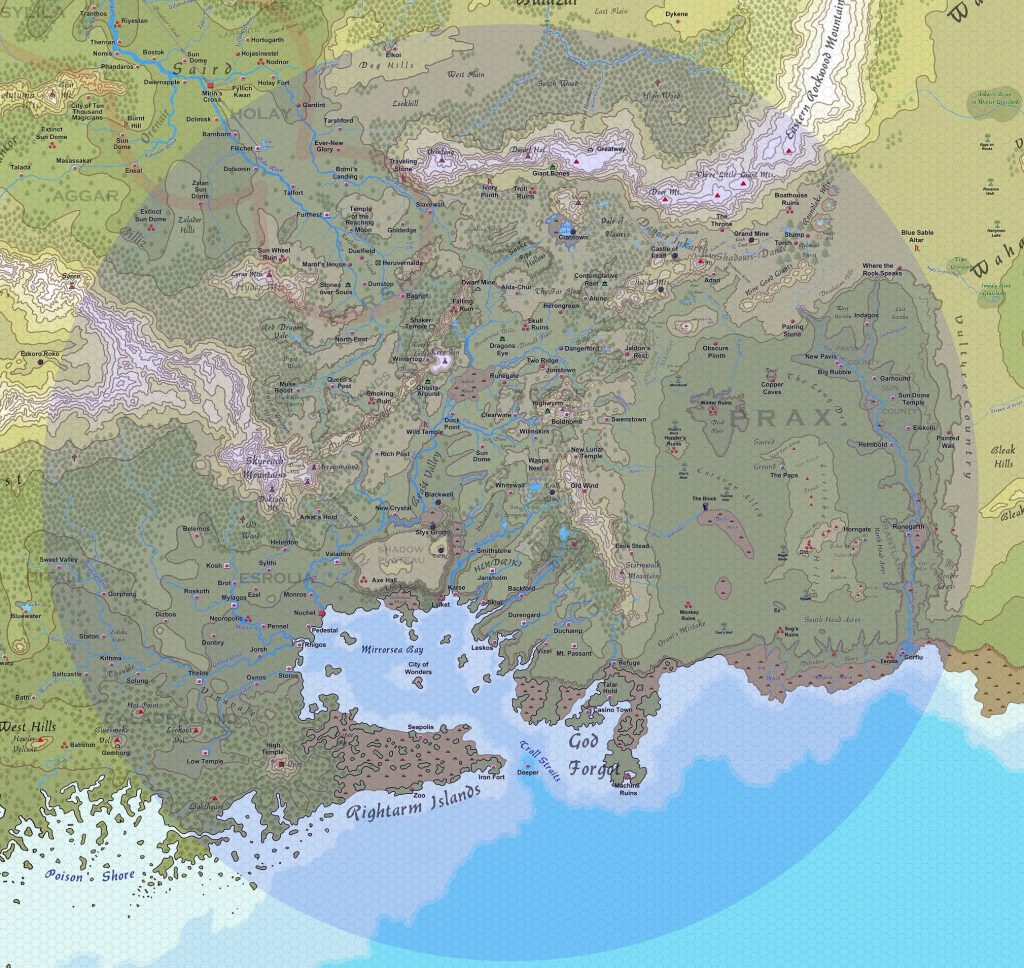
Most of 1621 and 1622 was one long winter in Dragon Pass, and Air and Earth magic didn’t work much or at all, with the epicentre of this tragedy at Whitewall, where the last Orlanthi resistance fell to the Red Emperor’s forces. Kallyr Starbrow and King Broyan eventually fixed the problem with some heroquesting of their own. This all happened a few years before the start of RuneQuest Glorantha’s official timeline, but for those who play in the more “classic” timeline of occupied Sartar, the Windstop is an interesting challenge.
During the Windstop, initiates of Orlanth and Ernalda within the affected area could not use their Rune Point pools to those gods and subcults of those gods. That includes Orlanth Adventurous, Rex, Thunderous, and Vinga.
Tatius the Bright expected that it would cause the Orlanth cult to collapse, but instead, Orlanth’s associates stepped into the gap. Chalana Arroy, Eurmal, Issaries, Lhankor Mhy, Storm Bull, Maran Gor, Babeester Gor, Grain Goddesses, and many others (including friendly cults such as Humakt) took on a greater social and magical prominence during that year. When the Windstop ended, the respect for the Orlanth and Ernalda cults actually rose as their importance in maintaining the cosmos was made more vivid.
Tatius the Bright was the General of the Lunar Provincial Army at the time.
Now part of the reason the default setting is moved to after the Dragonrise is that the Windstop is IMO better handled in retrospective. We didn’t think the default campaign path should be to make up a character in either of the two most popular player character cults and shortly after be told, “Sorry, none of your magic works.” And then keep that up for another three seasons or so. Obviously, if you want to play that, do it. But we concluded it was a far better idea to put that and the Dragonrise in the near past, and move forward from there.
As far as I’m concerned, that is perfectly sound reasoning. That, plus the fact that among the many old-school RuneQuest fan, a fair share of them might have grown tired of the Lunar occupation years…
Grazelanders Again
We had some notes about Grazelanders in previous issues of the Journal, but Jeff shared a summary:
So when thinking about the Grazelanders, it is perhaps best to think of them as a duopoly headed by the Feathered Horse Queen. That means two groups:
Semi-nomadic horse herders. These folk call themselves the Pure Horse People but would be barely recognizable to their distant kin in Pent and Erigia. Others call them the Pony Breeders. They raise and defend their horses, moving them around from pasture to pasture, supplemented by hay grown by the farmers. They are provided with additional foodstuffs, crafted goods, and so forth from the towns and villages, but in amounts set by the Feathered Horse Queen and acceptable to both groups. They worship Yelm and Ernalda.
Farmers and townsfolk. These folk are Orlanthi farmers, crafters, and merchants. They also include the Humakt cultists, who are the ferociously loyal bodyguards of the Feathered Horse Queen. They farm their fields, make craft goods, and run the markets – and give a percentage to the Feathered Horse Queen and to the Pony Breeders. They worship Orlanth Thunderous/Barntar and Ernalda, as well as the other Lightbringers and Humakt. Many have commercial or even kinship ties with Tarsh and Sartar.
This sort of co-dependence between farmers and nomads was pretty common in the real world. Farmers cannot easily become Pony Breeders, but are not slaves either. Disputes between the two groups are resolved by the Feathered Horse Queen who is above both groups, as the living incarnation of the Earth Goddess. The Feathered Horse Queen dynasty is closely related to the Sartar Dynasty and since 1605 or so to the Tarsh Dynasty in Furthest.
This is an important bit of information for anybody used to the older material where the Grazelanders are described as having Vendref “slaves” (I’m reading the HeroWars books at the moment and that word is used all the time in this context!) This new version of the setting seems more interesting and plausible to me so I like that this was changed.
The Feathered Horse Queen is very much the ruler. And she protects the farmers from the Pony Breeders AND the Pony Breeders from the farmers! The local Humakt cult is pledged to her service (likely as part of their initiation rites), and she controls the fertility of the lands and the herds. Life served by Death.
It is also worth keeping in mind that Grazeland society has been half Orlanthi farmer and half Yelmite horse herder for over a century or more. Both cults compete for the favour of Ernalda (the Feathered Horse Queen).
Finally, some numbers to get an idea of the group dynamics:
There are in total about 40k people in the Grazelands. 18k are Pony Breeders, 18k are farmers, and 4k are urban townspeople.
Reading Recommendations for Heroquesters
This is what Jeff recommends you take a look at:
When thinking about heroquests, I strongly recommend reading Jung’s “Red Book” aka the Liber Novus. That and “Inanna’s Descent into the Underworld”. And Gene Wolfe’s “Soldier of the Mist.” Those three books combined with “King of Sartar” and “Glorantha Companion [sic]” and you are much of the way.
By “Glorantha Companion”, Jeff actually mean “Glorantha Sourcebook“. Well, I’ve read 3 out of 5, so not too bad.
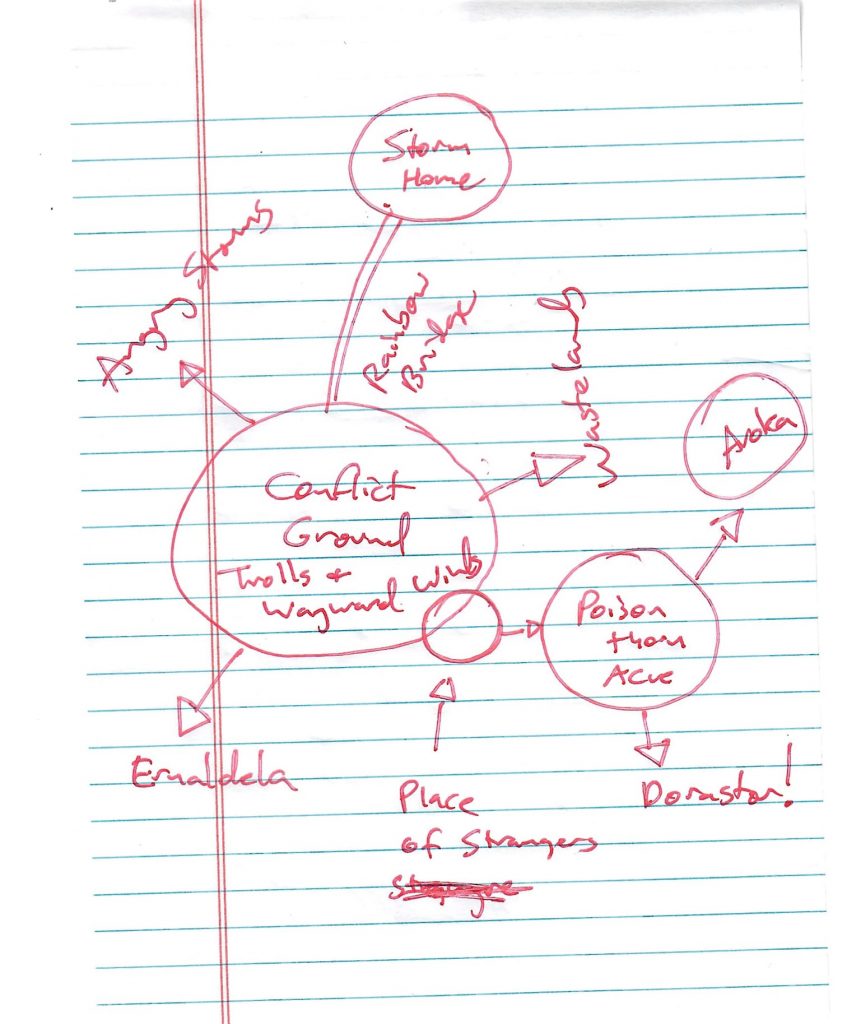
The above little diagram that Jeff shared with his note is “a map of part of the Hero Plane associated with the Aroka Quest.” So instead of organizing a heroquest as a linear list of “stations” as described in the old HeroWars supplements, Jeff seems to do a more classic sandbox of scenes, the way you might organize a normal adventure.
Gloranthan Art Series
Jeff has posted a five part series on Facebook about Glorantha art through the ages (part 1, part 2, part 3, part 4, part 5). Let’s get started, it might take a while!
Dawn Age
At the Dawn, there were basically two cultural centers – Dragon Pass (also known as the Theyalans or the Unity Council) and the Peloria lowlands ruled by the Horse Lords.
The Theyalans had a tradition of “realistic” art thanks to the Silver Age heroes called the Architect and the Artist (both of whom were active in Kethaela). Moreover, they had access to dwarf crafters, dragonewts and elves. And to surviving pre-Time relics. It followed geometric patterns of proportion and composition, and mortals and gods alike were depicted nude. This “Theyalan style” got spread all over the place, but also was probably really diverse. Individual artists did things in individual ways.
Example: Stravulstead, 1st Century, thought to be Heort
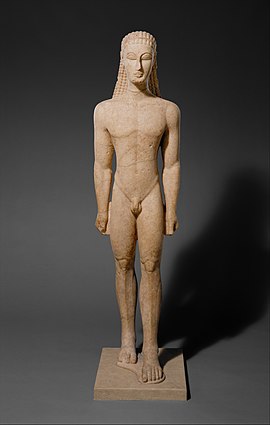
The reference for this statue is the New York Kouros, a life-sized marble statue representing a young Greek man. The statue was carved in Attica in the 6th century BCE.
Stravulstead was one of the settlements that existed at the Dawn in Dragon Pass. There are many of them (there’s a map in the Guide to Glorantha), but that particular one was in the heart of the Theyalan culture, just west of Dwarf Mine and near Grizzly Peak.
Heort is of course the founder of the Heortlings, and an early hero Orlanthi hero who participated in the I Fought We Won battle during the Gods War.
Meanwhile in Peloria, you start with court art that is intended to appeal to the Sons of the Sun. Lots of gold, horses, sun disks, etc. And it contrasts with Theyalan art by not being realistic or naturalistic. So very formal, very precise and almost abstracted at times.
Hey, there’s a reason why the Fire/Sky Rune is tied to the INT characteristic in RuneQuest. This kind of art is for intellectuals!
When Dara Happa is formed, the new empire takes some of the ideas of the Theyalans and starts making sculptures of important gods and rulers (who are the same thing).
And they look at the Gods Wall for style. Because of course there are Pre-Dawn relics. Just like in Dragon Pass – we have relics from ancient times. Broken statues of unknown gods.
The Dara Happan Empire was, I think, something that existed in the God Time under the Sun Gods. It wasn’t much of a thing anymore at the Dawn (as you might expected after the Great Darkness of the Gods War), but it was “re-established” in 221. It didn’t fare very well in Time, being defeated and occupied by their western Carmanian Empire neighbour, and then absorbed into the nascent Lunar Empire in the beginning of the Third Age. Remember that, since we’re going to reach that point soon.
The Gods Wall is that thing you can see on the RuneQuest Gamemaster Screen:

There’s a detailed appendix on it in the Guide to Glorantha, but you can also get it in a puzzle triptych!
We also start getting more and more concentrated wealth in the later First Age. Temples spend substantial resources commissioning artists.
By the 3rd century, the Dara Happan Empire and the High Council were in contact with each other and began to influence each other. The Theyalan Orlanth was identified with the Dara Happan Umatum and Rebellus Terminus, and Yelm with the Theyalan Emperor. Once the Dara Happan Empire joined the High Council of the Lands of Genertela in the later 4th century, this influence became pervasive and the mythologies were fused. This also influenced art, as artisan went among Dragon Pass to Dorastor to Dara Happa. A rich Yelm temple might hire artists, only for them to later work for a Heortling king or Orlanth temple. This results in a cross-pollination of symbols and style from Ralios to the Redlands, Peloria, Dragon Pass, and Maniria. Regional differences, but also common influences. The later First Age is a shared language of mythology, art, and culture.
You can thank the God Learners of the Second Age for not having to deal with all these different names for similar deities! Real-world archeologists and historians have to deal with that, but that’s really just overly complicated and confusing for a make-believe fun-times roleplaying game.
Second Age
This unified culture collapses in the Gbaji Wars at the end of the First Age. War and poverty. A collapse, which in turn leads to reduction in complexity in artwork. A Dark Age from about 450 to 600 or so.
In Dragon Pass, you end up with a vibrant civilization around 700. But they don’t have the dwarfs around to help them. And a lot more trollish influences.
Sculpture became less “realistic” and powerfully primitive. Basic shapes, essentially. But done with lots of wealth.
This is people working off copies of copies, without the skills to do it.
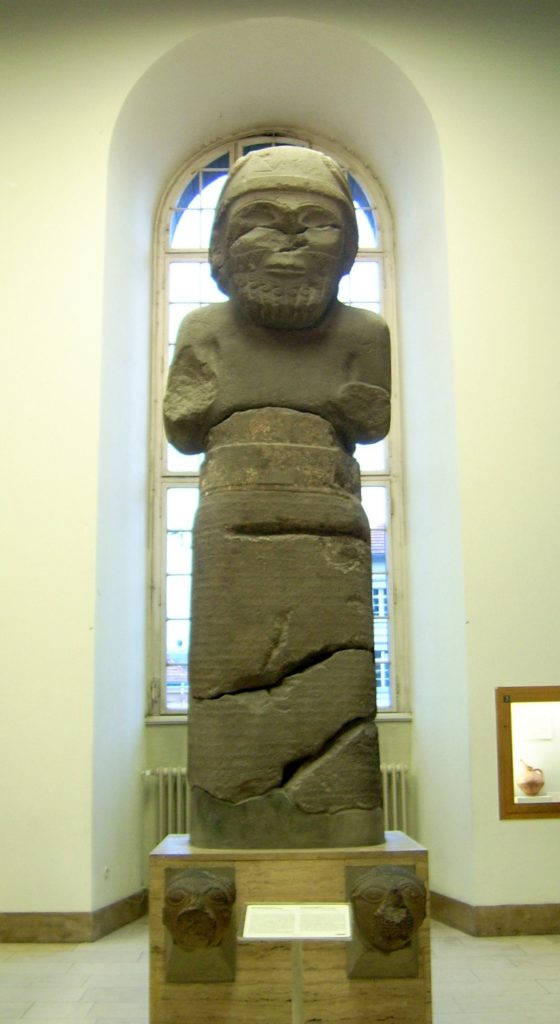
This reference is a statue of the Mesopotamian-Aramean storm god Haddad. You can see it in Pergamon museum in Berlin… the satue, that is. Not the storm god himself. Although frankly I’m half expecting someone to pop up and say “come on, Ludovic, in Glorantha, of course both are the same!“
Around 800 things change. The Dragon Pass kingdom gets extremely wealthy and obsessed with esoteric symbolism. And is in contact with the Middle Sea Empire. Things get sensuous and baroque. This is the formation of what we call the Esrolian style.
The reference picture that Jeff shared at this point was very low-resolution so I’m having trouble finding where it comes from… but it looks to me like a Hindu high-relief sculpture like this one, from the Brahmeshvara temple in Kikkeri:
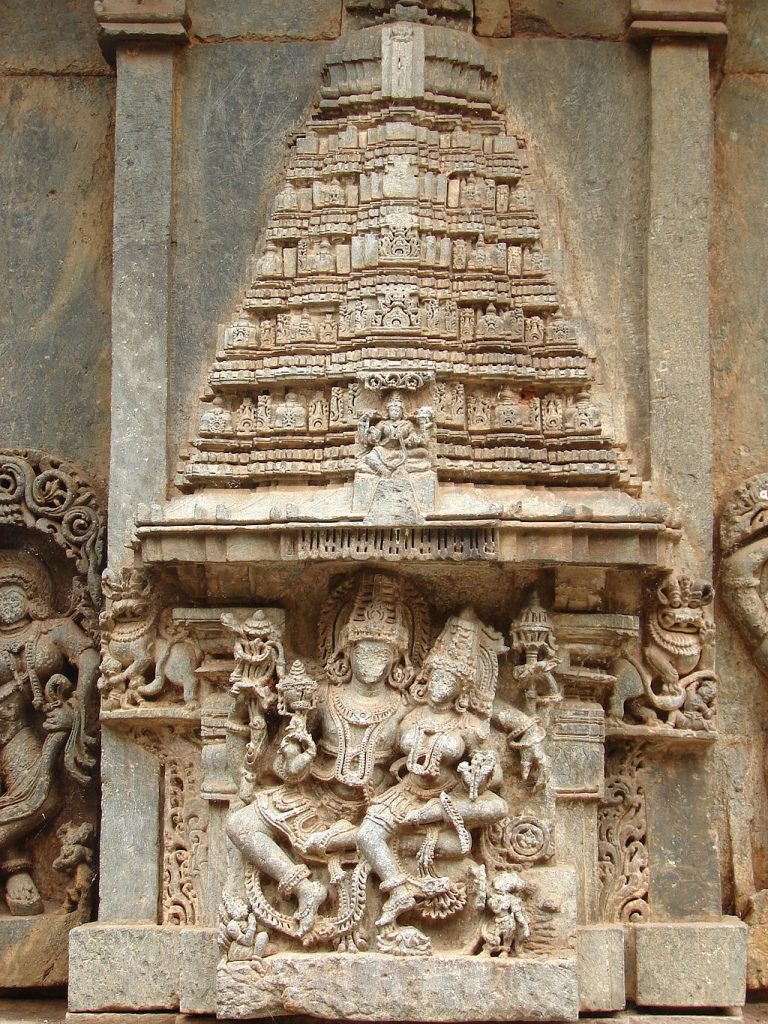
This piece is described as “Vishnu and Lakshmi under a Vesara aedicule” and if you’re like me, maybe the only words you understood there are “and”, “under”, and “a”.
Ok, I’m being a bit facetious because I have a vague idea who Vishnu is. He’s one of the principal deities in Hinduism, and he’s sometimes depicted as a… hold on… a blue guy with four arms? He “creates, transforms, and protects” the universe? He “restores the cosmic order” when the universe is “threatened by Chaos”? Oh hey, that reminds me of someone…
Lakshmi is Vishnu’s consort, although from the looks of it she doesn’t map as directly to Ernalda. She seems a bit more like Dendara (Yelm’s very respectable wife), with some Asrelia for the “wealth” aspect, and a few other things thrown in.
A Vesara is a specific architectural type of Hindu temple, and an aedicule is a type of shrine typically built as a niche with one or more statues inside. Huh. Oh well, those are my new English words of the week.
Anyway, the point is: art budgets are increasing thanks to trade money, so artists have more time to add more overly symbolic and detailed necklaces on everybody, a few extra arms for good measure, and complicated patterns all around the thing.
Whereas the Middle Sea Empire is more Hellenistic baroque. Very idealized baroque work.
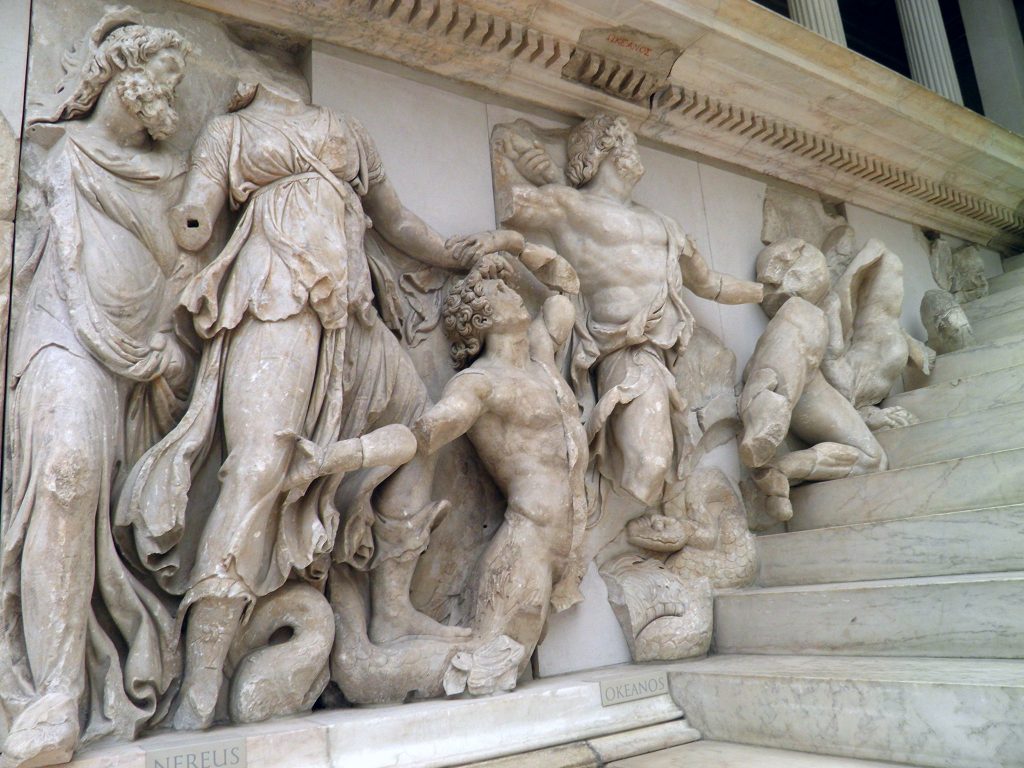
Jeff’s reference here is a detail of the (checks notes) gigantomachy frieze of the Pergamon Altar. What? Seriously, are people just inventing new words now? Ok, so the Gigantomachy is the name of the battle between the Giants and the Olympian Gods in Ancient Greek and Roman mythology.
These cool sculptures are again at Berlin’s Pergamon museum. It’s a massive exhibit, check it out:
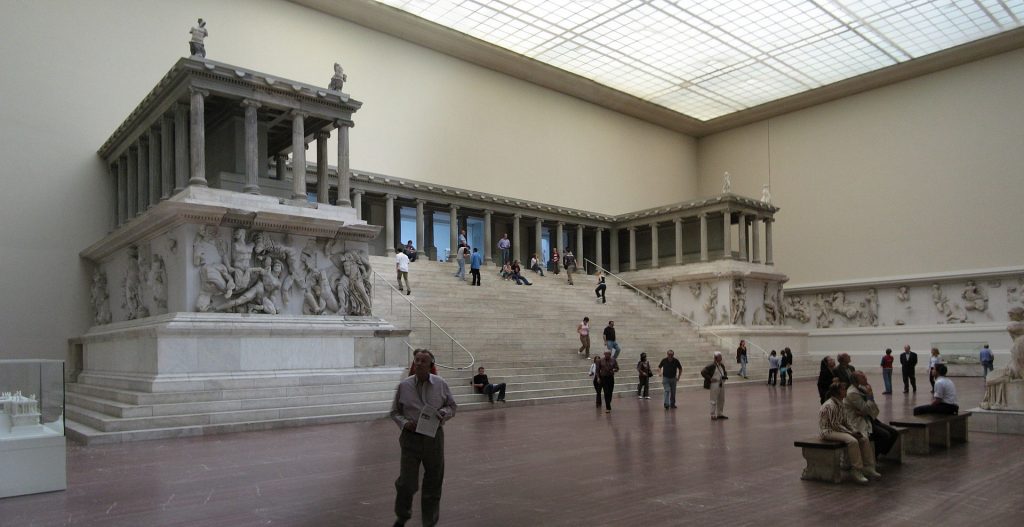
This was built in the 2nd century BCE in Pergamon’s acropolis. This is another one of Ancient Greece’s many cities founded on the other side of the Aegian Sea, in modern day Turkey.
Where the EWF is going for Indian baroque, the Carmanian and Dara Happans are going for something more austere and idealized. More stylized and austere styles in the north, more “naturalistic” and descriptive art in the south. To put it roughly, the Pelorians evoke ideas, the Theyalans depict things.
Carmania establishes a much less baroque and more austere idealized style in Peloria. Which, in turn, echoes the divide that existed before the First Age too.
The next reference picture is, I think, from the “Lion Hunt of Ashurbanipal“. It’s a mural from one of the palaces in the Assyrian city of Nineveh, built in the mid-7th century BCE.
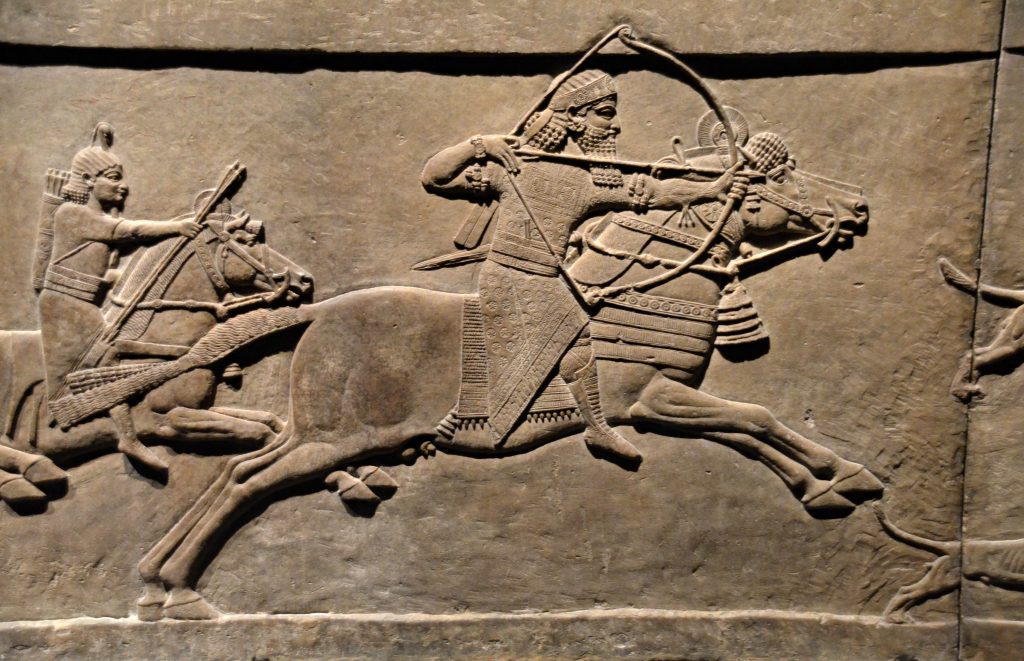
Here you can see him actually fighting the lion:

If you live in San Francisco, or if you like stupid internet memes like me, you might have already seen this guy wrestling that lion… the San Francisco statue below has been described as “…when you need to stop the cat from running outside while you’re getting that Amazon package“:

We are of course talking about the richer temples and rulers. Smaller temples are left behind. Villages shrines still do stuff like this:

This is a picture of an early 7th century BCE votive figure attributed to an Ancient Greek noble named Mantiklos. It was an offering to Apollo. We know this because it’s written on the figure’s legs: “Mantiklos dedicated me as a tithe to the Far Shooter, the bearer of the Silver Bow. You, Phoibos [Shining One], give something pleasing in return.” You can see this in the Museum of Fine Arts in Boston.
In RuneQuest, that’s the kind of stuff your adventurers might leave at various temples to get those bonuses when replenishing Rune Points. You can even make it a full-on action figure, complete with accessories! Indeed, this Mantiklos votive figure has “…marks of attachment on the top of the head and a hole for attachment in the forehead. The hole in the left hand has been identified as support for a bow. It has been suggested also that the figure was a warrior, wearing a helmet and carrying a spear in the left hand and a shield on the right arm.“
The Middle Sea Empire influences Esrolia – you get rich temples hiring crafters from across the Middle Sea Empire for technique skill. Esrolia is super cosmopolitan, and its artists might throw in weird references from Kralorela or Fonrit or Seshnela or whatever. So in Esrolia, you basically establish super-baroque. Great technique, lush symbolism, but very naturalistic and sensuous.
The reference picture for this part is some of the sculptures from Khajuraho temples in northern India.
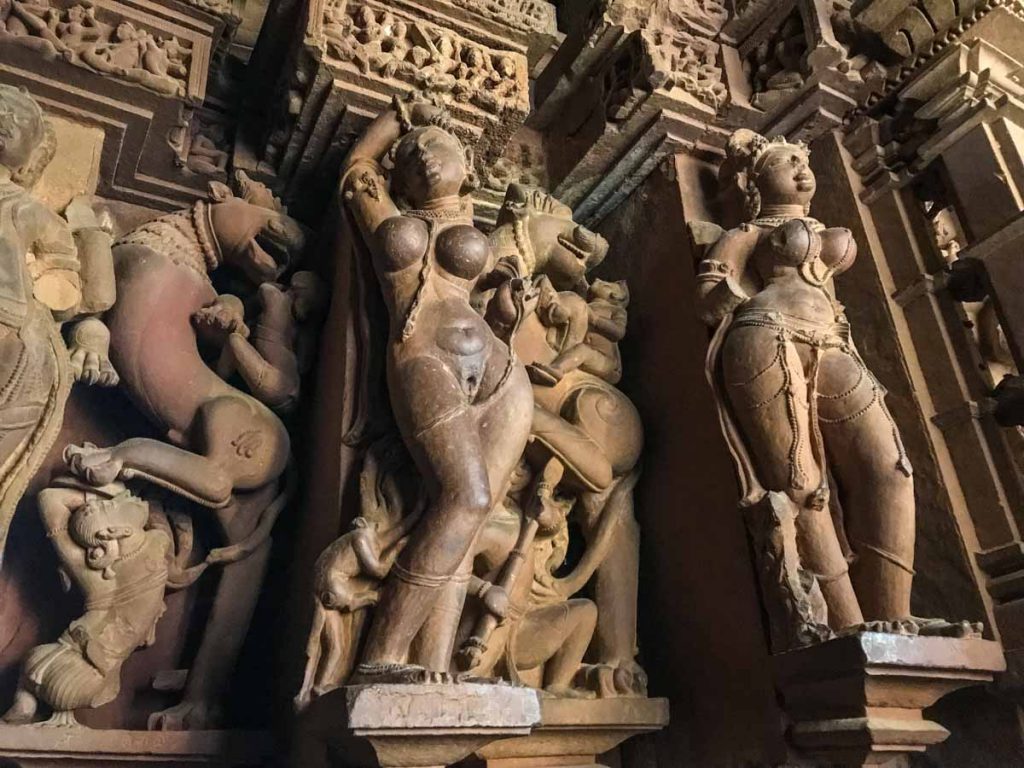
These temples, built between the 9th and 11th centuries CE, are famous for their erotic sculptures. These only represent about 10% of the numerous sculptures decorating the site, but of course that’s what tourists come to see. And given what they look like, it seems obvious that it’s a great idea to take family pictures there. “Naturalistic and sensuous” might become a lot more hard-core in some select Kethaelan temples…
In Dragon Pass and South Peloria, it is as baroque, but less sensuous and more abstract and symbolic. Here the influence of the dragons is the greatest.

And in Peloria, it is more austere, idealised, and formal. Also they have the Gods Wall to go back on.
Now Jeff shows us various ways to depict Ernalda:
In Esrolia, she is depicted as this lush and sensual dancing woman, surrounded by a dazzling array of flowers, grains, husband protectors, worshipers, lesser goddesses. She overwhelms with splendor to the point where your senses can’t even take it all in.
Another northern India statue is used for reference here:
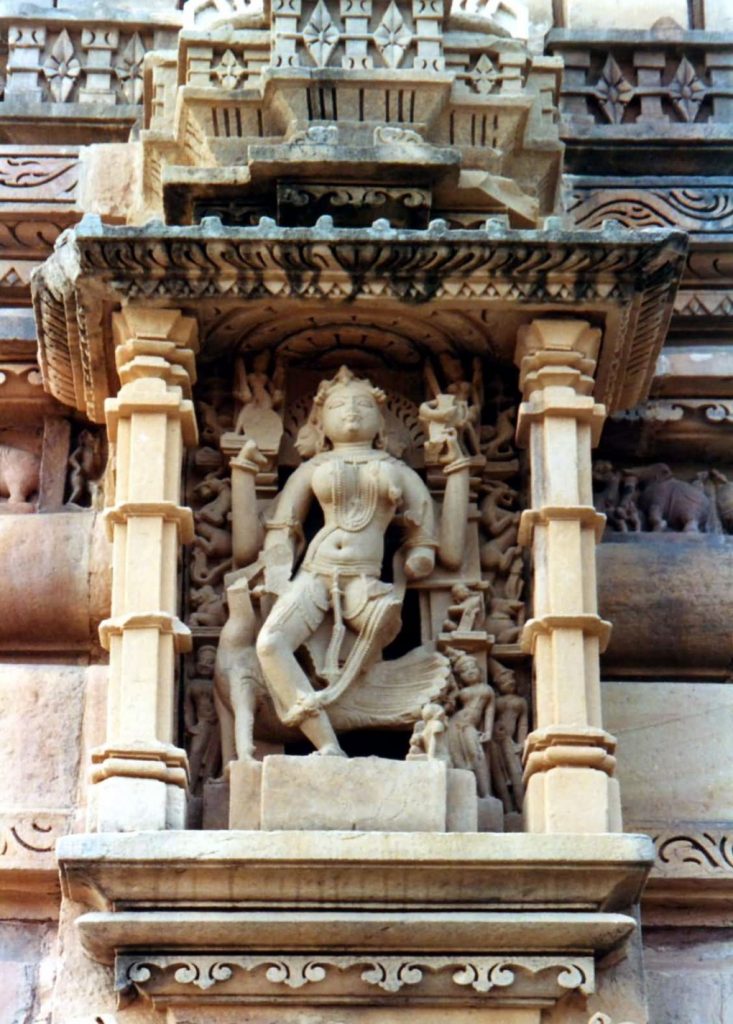
I think this is a sculpture of the goddess Kaumari, a war goddess who rides a peacock, carries a spear and axe, and has several cool powers. She is one of the Matrikas, which are also known as (checks notes) the Seven Mothers. Oh hey! Well, I’m not going to go deeper into that because it seems super complicated and deals with various sub-types of Hinduism, but that should be enough to whet you appetite — in particular, I’m totally going to have an Ernaldan or Babeester Gor NPC riding a peacock, now.
But anyway, if I’m still following Jeff, this would be one way to sculpt some representation of Ernalda. But there are others:
In Peloria, she is very formal and strict. She looks much like the other goddesses, just more so. Or maybe she is naked and the others are clothed.
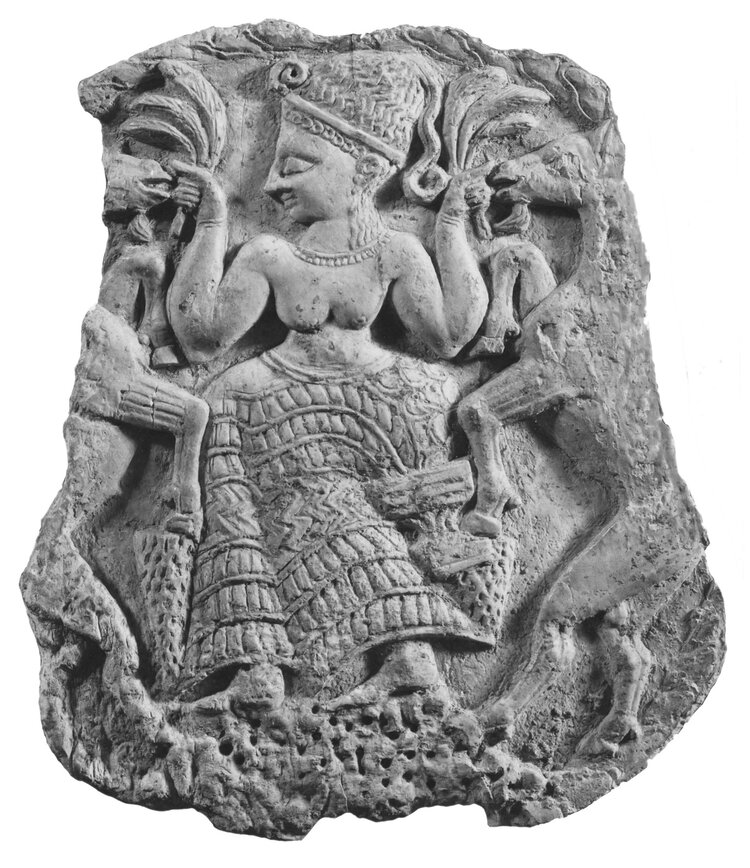
This is a sculpture of Asherah, a “mother Goddess” of ancient semitic religions. She was widely worshipped throughout the ancient Middle East, often as the consort of this or that god, like Ernalda is in Glorantha. And while Asherah was wed with various big deities in Caanite, Hittite, Assyrian, and other religions, her claim to modern fame is probably as a consort of Yahweh in Israelite religion.
In Dragon Pass, she is looser than Peloria, dancing like she is in Esrolian artwork. There are still goddesses, husbands and flowers around her, but there is also other stuff. Strange runes, which almost look like hers, but aren’t. The snakes around her look…odd, and not quite right. And some of the flowers do not look entirely real.
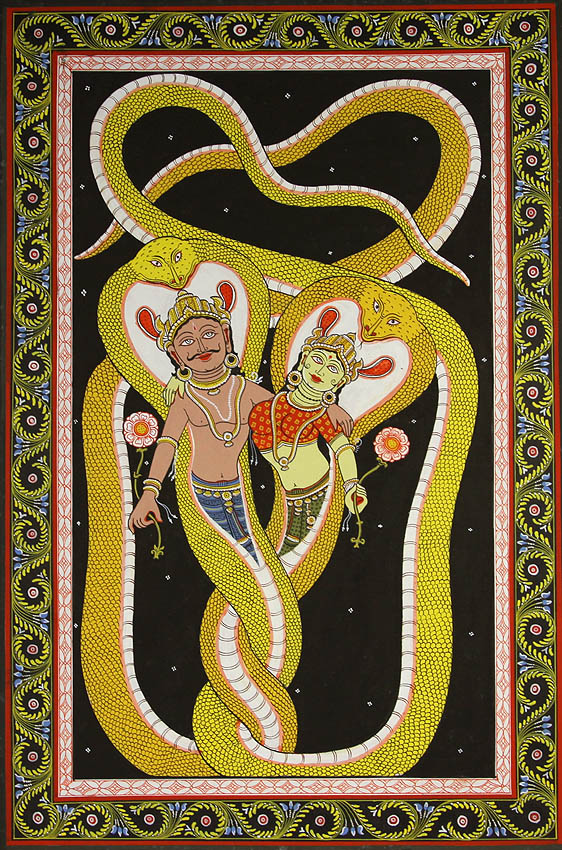
This is, I think, a picture of Nagaraja with his wife. Now I’m not clear on who Nagaraja is, because it might be less a person and more a group of persons. They are the kings of various types of serpents, although it seems like the Hindu texts mostly refer to three main kings. And yes, if you’re enough of a Gloranthaphile, seeing serpent kings with serpent legs should be firing all kinds of cylinders in your head.
But again, ignore my digressions: this is supposed to be how Ernalda might be depicted in Dragon Pass. She would be as liberated and sensual as in Esrolia, but with more weird draconic mysticism, I guess.
During the period from 878 to 910 that the EWF rules Dara Happa, elements of this style gets imposed along with traditional formalism.
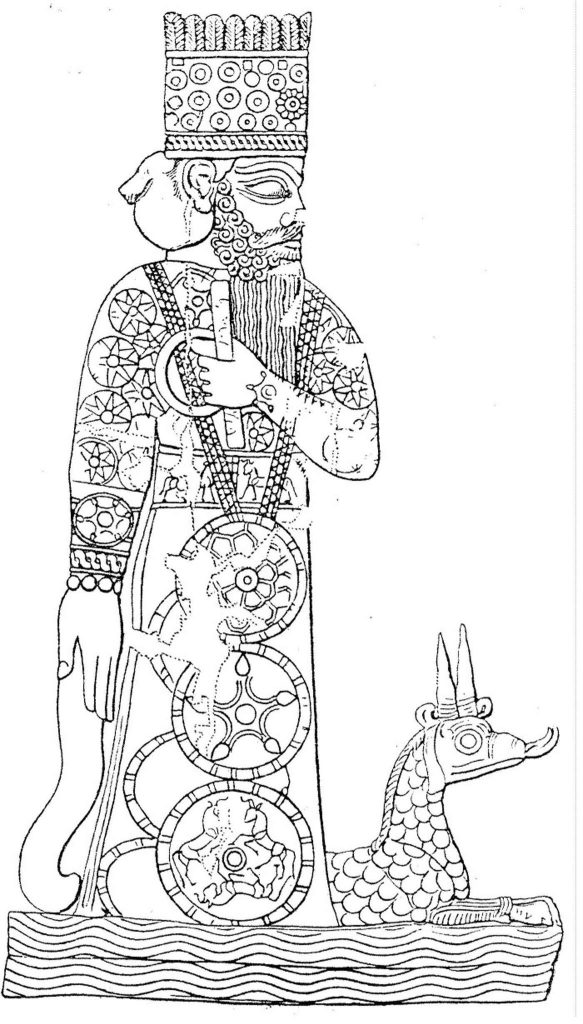
Ah, finally a reference picture I can somewhat place: this is good old Marduk, a big shot Mesopotamian deity, and city-god of Babylon, no less. The drawing above is a depiction of the Statue of Marduk inside which the god was believed to reside.
So I suppose that Dara Happan traditional art style is augmented with weird bits about dragons and snakes, basically.
Then the seas Close. Esrolia is cut off from the Middle Sea Empire, and its art loses some of its technical brilliance, and gets even more baroque and less understandable.
Meanwhile in Peloria, the Carmanians react against the most obviously EWF stuff, but they are conquering and expanding, so they are hiring artists trained by the EWF but being told Be More Formal!
Third Age (Holy Country)
And then comes a long period of war that culminates in the Dragonkill War. Which divides the world into Kethaela and Peloria.
Kethaela starts with that late Second Age Esrolian style. Sensuous and baroque. Though regressed a bit and gets worse and worse at it. Since you don’t have the actual artisans present anymore.
Until Belintar shows up. And Belintar oversees a rich artistic renaissance. And he’s of course a thorough God Learner, with baroque references on top of baroque references. So the style remains mostly the same, but revitalized. Not “realistic” but symbolic and mythological.
And he draws on the Esrolians, the Heortlings, the Caladralanders, the God Forgotites, the trolls, and the dwarfs to create a visual melting point. And the Kethaelans get their technical skills back. The way the ornamentation and detailing is made is changed as a result of communication from the dwarfs of Gemborg. Intricate decoration.
At some point, the style is a reference to a reference to itself. So whereas the Second Age stuff was naturalistic verging on weird abstractions (like in the eyes and so on), under Belintar, temple architecture was naturalistic but not formalized.

This “plaque with female figure” dates back to the 1st century BCE in East India, and is housed in the Ashmolean Museum in Oxford. So while there are style similarities to the previous Indian pieces, this one is definitely less intricate and crazy-looking. In the real-world it’s because it’s an earlier piece using a different medium, but in Glorantha that would be because local artists have lost their EWF drug dealers.
Belintar tries to recreate that very spread out and universal First Age Style. And of course this just goes nuts with the Opening. Because the Holy Country is now stupid rich.
Now when Sartar gets settled, they bring this artistic tradition with them. Sartar and his heirs hire artists from the Holy Country. But Orlanth is the focus. It is not as baroque. It is more martial, more masculine. And somewhat technically cruder, except for the dwarf or Wilms-made stuff from Sartar’s time. Which is technically superb. More masculine, more martial, more violent. And even more individualistic.
Artists are very much encouraged to put their own spin on things. The overall style is there, of course, you can’t really escape it.
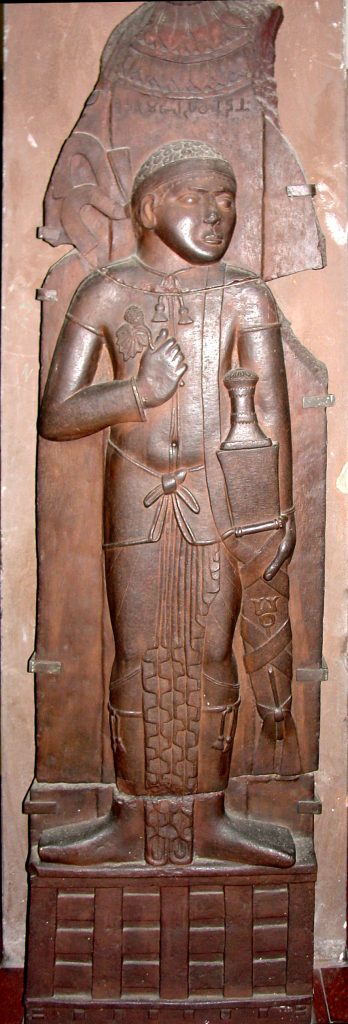
Jeff describes this picture as a “statue of a Sartarite Chieftain or King“. In the real world, it’s the Bharhut Yavana, from northern India in around 100 BCE. Indeed, less exhuberant detail and more serious.
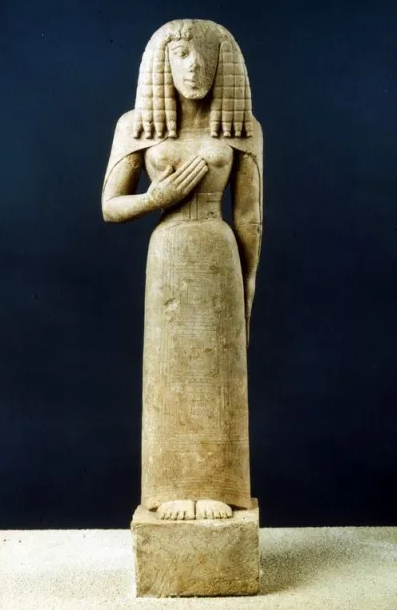
This next reference is an “Ernalda cult image“. In the real world, it’s the Lady of Auxerre, currently housed in the Louvre Museum in Paris. It dates back to the 7th century BCE, and was probably related to some Ancient Greek goddess like Persephone. As always, we tend to see the past as monochrome, but this reconstruction shows how colourful it might have been:
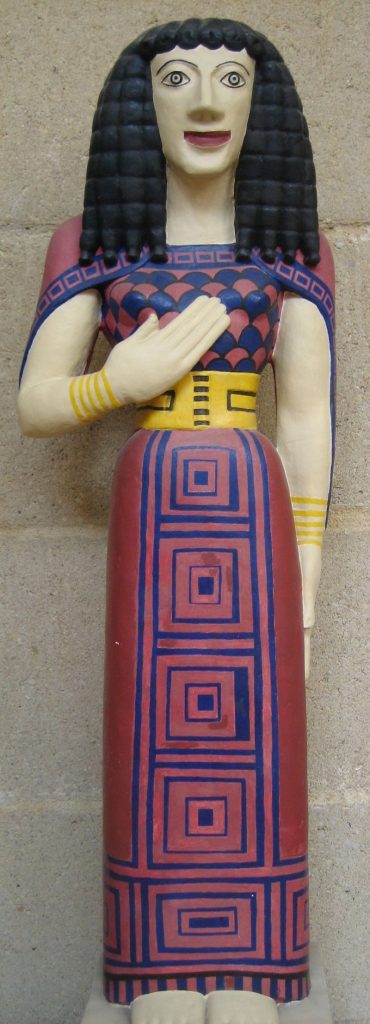
Next, some reference for “Sartarite coin art“:
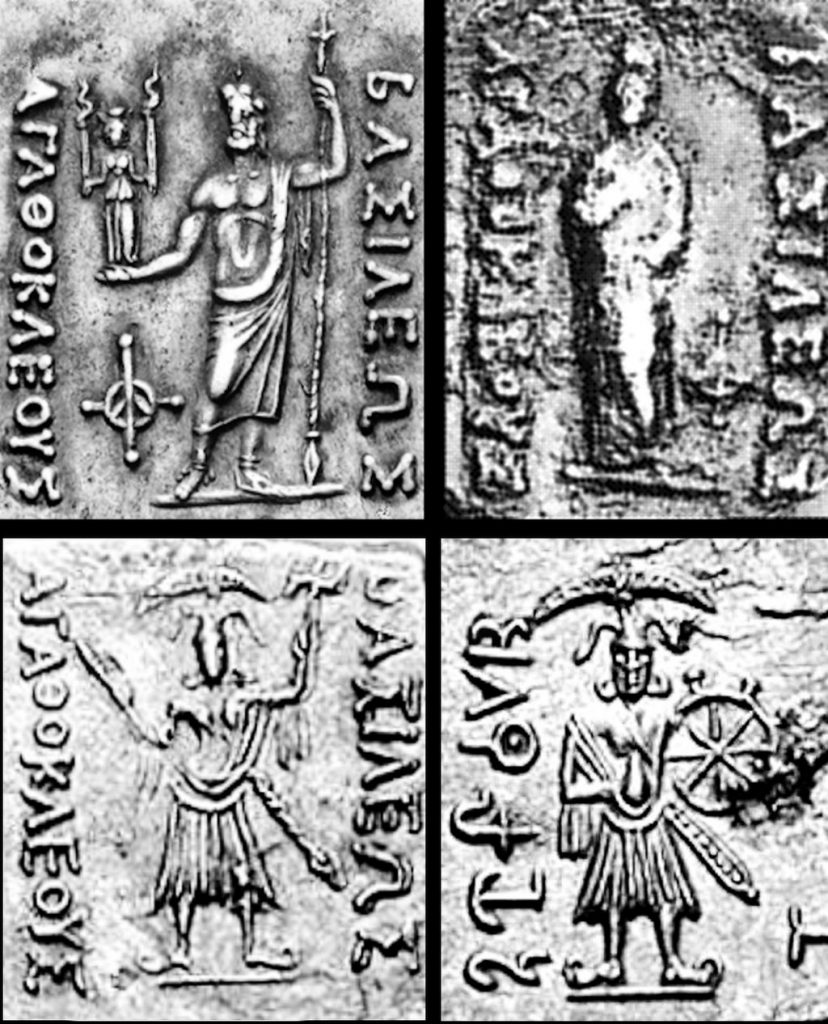
In the real world, these are coins from the reign of Agothocles of Bactria, in the late 2nd century BCE. Apparently we don’t know much about the guy, but we know a LOT about his coins! Of note, these coins show a mix of Greek and Indian deities, so good on Agothocles for the multiculturalism here.
If you’ve seen the coin art in the RuneQuest rulebook or the Guide to Glorantha, the similarities are obvious. And remember that you can get real Glorantha coins, courtesy of Campaign Coins!
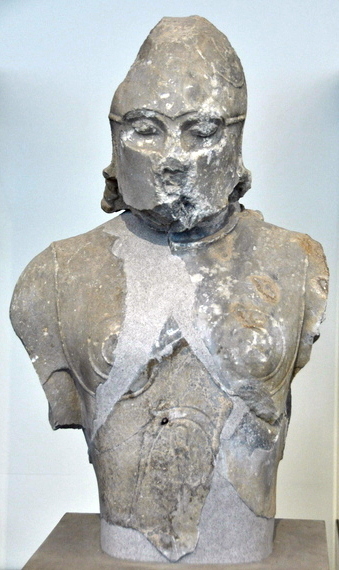
Finally, this is a reference for “King Tarkalor”, who was Prince of Sartar and King of Dragon Pass in the late 1500s before being killed by the Lunars at the Battle of Grizzly Peak.
The actual image is the 6th century BCE life-size statue of an unknown or unnamed hoplite warrior found in the temple of Hera in Samos, an island in the Aegean Sea. There’s more here, but again, this is very martial and, frankly, plain.
The Lunar Empire
But, in Peloria, things are different. The EWF style are gone. And we have a long dark age.
The Carmanians embrace a formal brutalism style. Them and their gods triumphing atop piles of dead. Think Assyrian palace style. Scenes of war and scenes of authority.
Jeff doesn’t share any reference here, but hey you come here for the useful annotations, right? Here’s what an Assyrian palace might have looked like during the height of Assyrian cities from, say, the 14th century BCE to the 7th century BCE:

So not as brutalist as a 1960s communist monument, but still pretty concrete square looking. And here’s what the inside might have looked like:
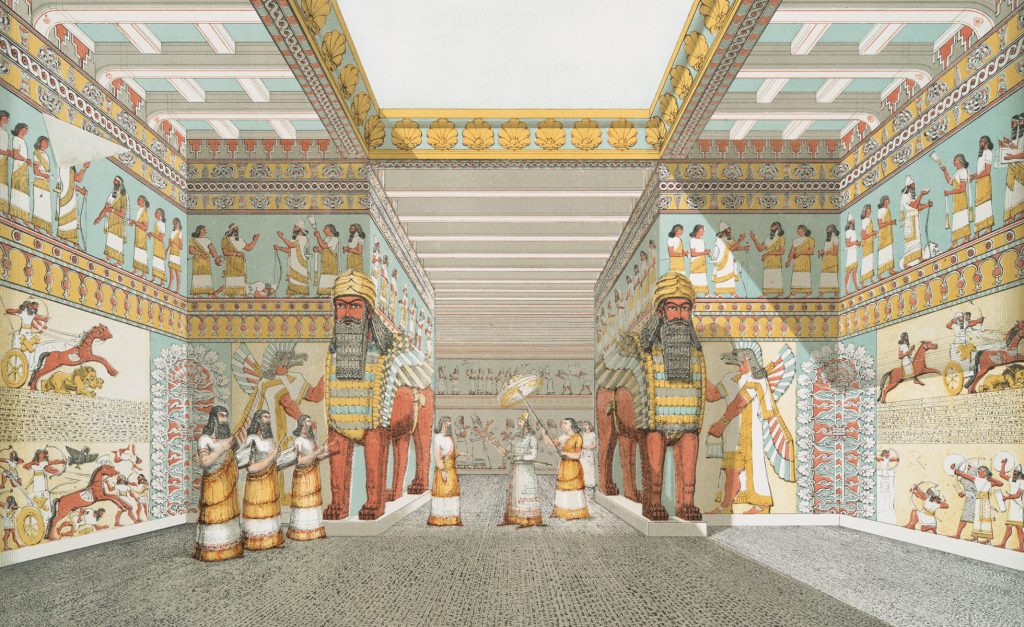
There are more pretty pictures and information here. Generally speaking, it seems like you can use Assyrian cities such as Assur, Nimrud, and Nineveh as inspiration for your Glorantha’s Dara Happan cities like Raibanth, Alkoth, and Yuthuppa.
The Lunar-Dara Happan revolt comes out of that tradition but tries to turn it upside down. With a naked goddess being the equal of a stern but benevolent Yelm. Standing on top of a pile of dead Carmanians and Pentans.
But also we start getting new esotericism. It could be that the Red Goddess was not even initially depicted as a deity. But just as a woman. Deliberately smaller than the gods and rulers. Naked and human, but superior to the immortal gods. And she is not depicted in a formal manner. Idealised yes, but relaxed and in dance. The Yelm cult takes its cues from here as well. Yelm gets less formalized, although continues to be idealized. Maybe even more idealized.
Sedenya is basically the girl next door that your worshippers told you you don’t need to worry about. But hey, what’s that? Your worshippers are now wearing Red Moon t-shirts? Uh oh.
As the Lunar Empire gets richer, the art gets better, and becomes what we now call the Old Lunar style.
We get a century and a half of this Old Lunar style. And then in 1375 the Pentans come. And for nearly a century, the Pentans reduce Peloria to grasslands. People are eating mud and each other. The Lunar Empire consists of the besieged center of Glamour, some barbaric kingdoms in the south, and the Western Reaches aka Old Carmania.
Lunar art becomes cruder, poorer, and more emphatic. There is now no difference between Lunar and Dara Happan. There is simply Lunar-Pentan-Slave. Empathic in subject and very removed from the concerns of the world. Because in the real world Sheng Seleris rules. Minor victories or stalemates against Sheng Seleris are monumental triumphs!
In a surprise, the Red Emperor defeats Sheng Seleris and confines him to a Lunar (ie mystical) hell. The Pentans collapse. And now the Lunar Empire is able to resettle the New Grasslands of Peloria. This is where Lunar art comes from. Restore and Rebuild. New towns need to be built. Old cities need to be rebuilt.
All quickly, all at the same time, and from the Oronin River to the Arcos. From the White Sea to the gates of Alkoth. Every town gets laid out more or less the same, with a temple complex to the Red Goddess, Yelm, Dendara, Lodril, and whoever else. All by the same architects and artists.
And although directly supervised by the Red Emperor, Great Sister, or Hon-eel, it is initially done fast and on the cheap. And some a lot better than others.
So we now have within the empire basically four styles. Three are old and can be found in:
1. Glamour and the Tripolis
2. Western Reaches
3. Jillaro
4. Everywhere else: The New Lunar style or the Lunar Heartland style.Towns are built quick. And cheap. Art is initially easy to reproduce. Very stylized and formalized. But over the next century and a half, the empire gets richer and richer and richer. So this New Lunar style gets built upon, embellished, upgraded. More elaborate and more technically skilled. But it is still based off that original post-Sheng style.
But now rich Lunar priests demand that the artist display technical virtuosity and work in all sorts of Lunar motifs and esoteric references.
I guess that’s what happens when the upper crust of the Lunar society starts to accumulate many rich second generation assholes and crazy Illuminates.
During Sheng’s occupation, the shift towards more empathic and non-real world related themes in art also brings in another thing. The artwork starts to depict Yelm, Lodril, Dayzatar, and all the others as idealized and perfect. These almost calming presences in the world, a source of stability amongst the chaos and horror of Sheng’s rule.
Yelm is no longer that stiff, formal, restricted thing on the Gods Wall. He is still that yes, but to the masses he is also the benevolent sun god. And the Red Goddess’ divine father.
This reminds me of this theory about western genre movie production, where we supposedly get more dystopian stories when the economy is good, and more zombie and post-apocalyptic stories when the economy is bad.
As the occupation ends, as more art gets made and the more and more money gets pumped into it, this transforms.
The Seven Mothers, Etyries , Hon-eel, etc. are depicted in a sensual, loose and free style. They are beautiful and relatable.
The Celestial Gods meanwhile are beautiful, yet perfect. They are not sensual; they are not mere mortal things. They are the perfect geometry of the world, the cosmic order.
A depiction of Hon-eel or Jar-eel or Etyries shows you an idealized reflection of you, the mortal viewer.
They were born, they suffered, they transcended. Like the Goddess herself.
The depiction of Yelm shows you something else though. something still beautiful, but in a different way. It is the beauty of perfect harmony. The beauty of the cosmic order of the Golden Age.
So let’s move this forward a tiny bit more. By the 7th Wane, the Lunar Empire is ruled by Yelm illuminates of the Red Goddess cult. For generations. They are self-referential by now in the sense that their art needs to communicate with them and not so much other audiences. So in our magnificent great temple in Glamour, with gold and gems and glass, abstract depictions of Yelm and statues of Apollo, we have this crude little gold sun disk on a horse from the Dawn.
What Now?
Well, this was fun. I think all this pile of information might be interesting to use for environmental storytelling. The way the gamemaster describes a given relic, loot item, temple, ruin, or vision from the past could use this Gloranthan art history to give subtle hints about when and where it’s from.
Environmental storytelling is probably harder to do in a tabletop RPG than in, say, a movie or a video game, and it will probably fly right over the players’ heads, but it’s the kind of little easter egg that shows you care.
Community Roundup
The community roundup is our highlight of interesting things being mentioned in the Glorantha-related Facebook groups, sub-Reddits, and other similar online places.
RuneQuest Year Zero Concludes
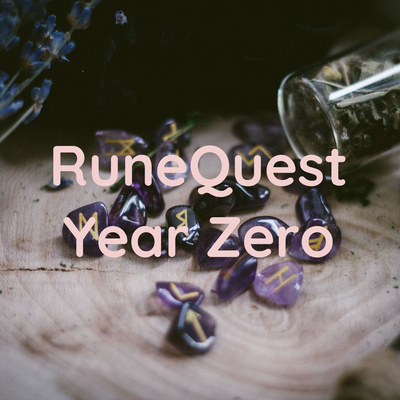
Baz Stevens’ deep newbie dive into the RuneQuest Starter Set concludes with an epilogue featuring only call-ins from listeners (you might hear my voice in there). I heartily recommend the whole series to any RuneQuest grognard, and I hope Baz gets to actually play a game soon.
The Vintage RPG on Glorantha
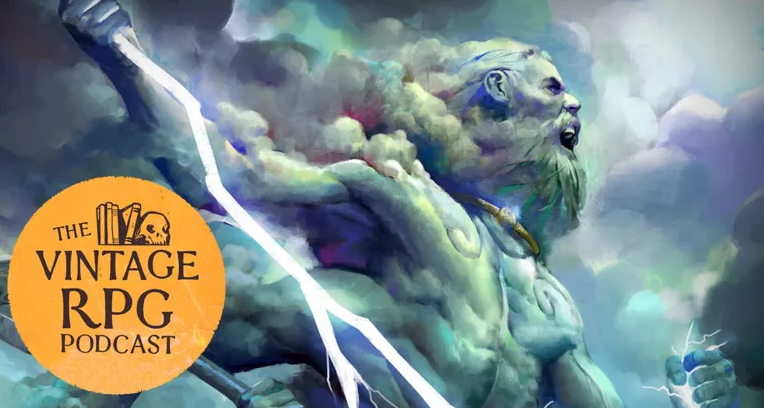
Previously mentioned Vintage RPG podcast has released an episode on Glorantha. It’s a nice presentation of the setting where one of the hosts explains the most mythical bits to the other host. It’s short and fun so check it out!
JM on Glorantha and Other Cool Things
The Live From Pellam’s Wasteland YouTube channel welcomes JM, of Exploring Glorantha and Jackals fame, to talk about Glorantha and other cool things. I haven’t watched it yet but hey, here you go.
Thank you for reading
That’s it for this week! Please contact us with any feedback, question, or news item we’ve missed!



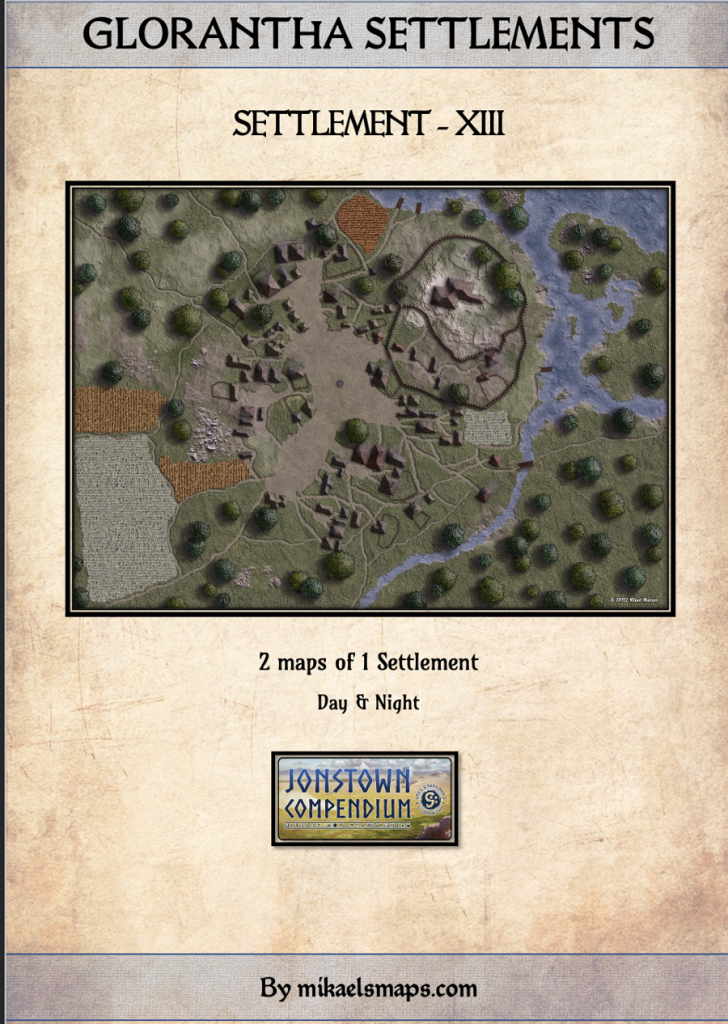
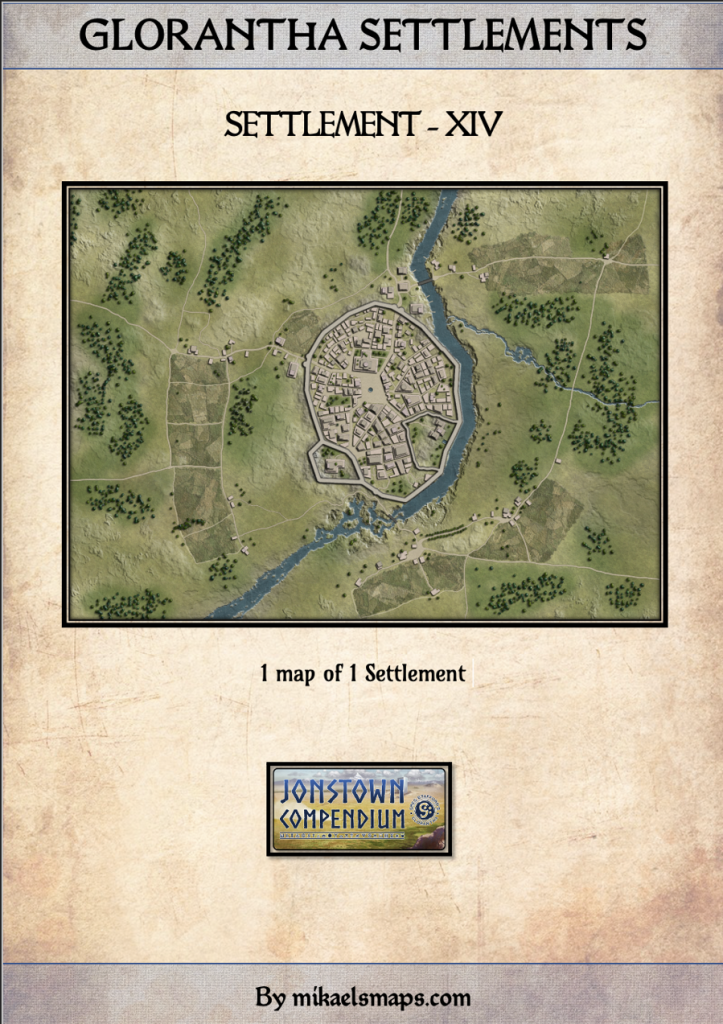

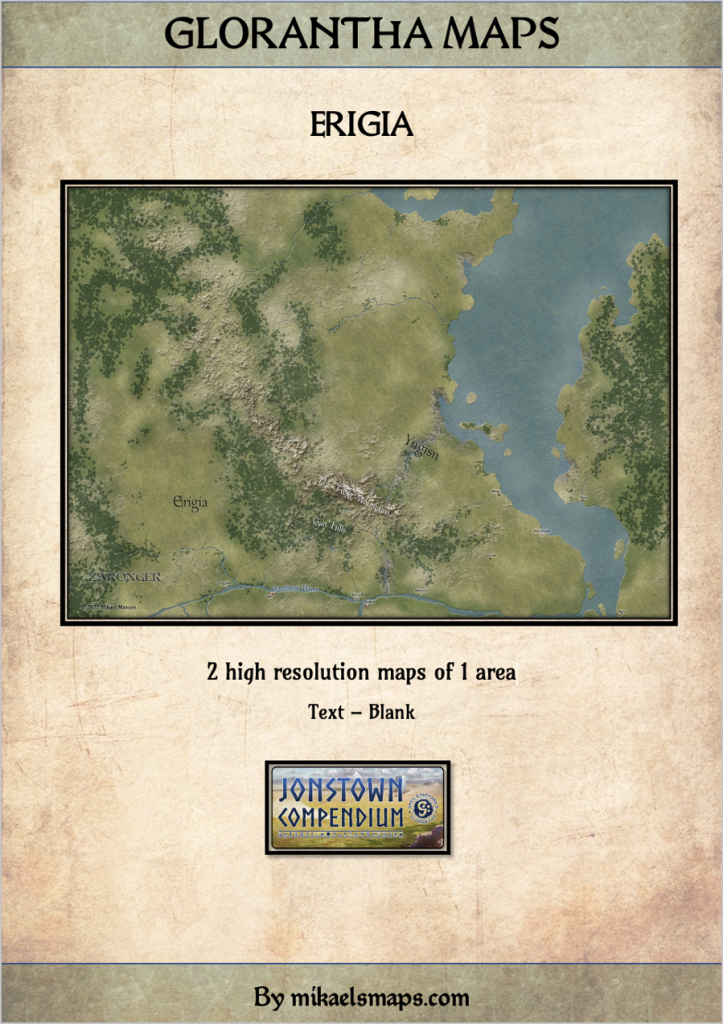
One comment on “Journal of Runic Studies #40”